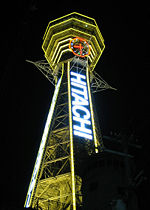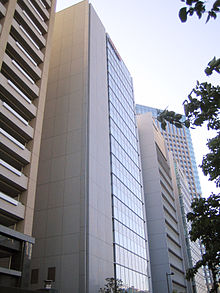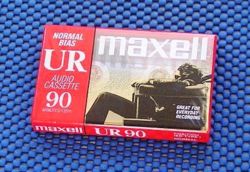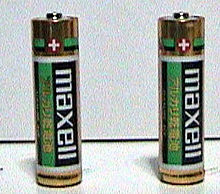- Hitachi Maxell
-
Hitachi Maxell, Ltd.
日立マクセル株式会社
Type Private Industry Electronics Founded Osaka Prefecture, Japan (November 7, 1947) Headquarters 1-88, Ushitora Itchome, Ibaraki, Osaka, Japan Key people Yoshito Tsunoda - President & CEO
Takashi Kawamura - ChairmanProducts Electronics firm Revenue  ¥12,203 billion 2006
¥12,203 billion 2006Net income  ¥ 204,131 million 2006
¥ 204,131 million 2006Employees Consolidated: 4,663
Non-consolidated: 2,024 (March 31, 2007)Parent Hitachi, Ltd. Website http://www.maxell.co.jp
http://www.maxell.com
http://www.maxell.eu/Hitachi Maxell, Ltd. (日立マクセル Hitachi Makuseru) , commonly known as Maxell, is a Japanese company which manufactures consumer electronics. The company's notable products are batteries -- the company's name is a contraction of "maximum capacity dry cell" -- and recording media, including audio cassettes and blank VHS tapes, and recordable optical discs like CD-R/RW and DVD±RW. But the company also sells electronics and several kinds of accessories, ranging from CD and DVD laser cleaners to storage boxes.[1] On March 4, 2008 Maxell announced that they would no longer manufacture their optical media, but would start contracting other companies to manufacture Maxell media.[2]
Contents
History
Maxell was formed in 1960 when a dry cell manufacturing plant was created at the company's headquarters in Ibaraki, Osaka. In 1961, Maxell Electric Industrial Co., Ltd. was created out of the dry battery and magnetic tape divisions of Nitto Electric Industrial Co., Ltd. (now Nitto Denko Corp.).
Ad campaign
In the 1980s, Maxell became an icon of pop culture when it produced advertisements popularly known as "Blown Away Guy" for its line of audio cassettes. The original campaign began as a trade ad in 1980 and was made into TV spots in 1979 which ran throughout the 1980s. Steve Steigman was the photographer[3] and Richard Wagner's "Ride of the Valkyries" was used for music. In the UK the music used was "Night on Bald Mountain" by Modest Mussorgsky.
The ads depict a man sitting low in a (Le Corbusier) LC2 high armed chair (on the right side of the screen) in front of, and facing, a JBL L100 speaker (the left side of the screen). His hair and necktie, along with the lampshade to the man's right and the martini glass on the low table to the man's left, are being blown back by the tremendous sound from speakers in front of him — supposedly due to the audio accuracy of Maxell's product. He is shown desperately clinging to the armrests but defiantly looking ahead at the source of the music through sunglasses, though calmly catching his drink before it slides off the end table. Television commercials showed the chair, as well as a drink and nearby lamp, moving back away from the stereo by the strong force of the sound waves. The image became the de facto standard of those who believed their stereo equipment had sufficient power or accuracy to move the mind and the soul. The model for the UK (not US) ad campaign was musician Peter Murphy of the group Bauhaus. The model for the US campaign, however, was the makeup artist hired for the shoot by photographer Steve Steigman.[4] The impact of the advertising campaign on popular culture still resonates today: "Blown Away Guy" was recently parodied on the popular animated television show "Family Guy" in the episode "Model Misbehavior". This is only the most recent in countless parodies over the years, which includes a parody in the John Ritter film Stay Tuned, (which featured a character's head being blown off by a "Max-Hell" tape). In the 2010 movie Jackass 3D, the commercial is parodied with Ryan Dunn sitting in the chair, while the blast from a Jet Engine send the set blowing away.
The original soundtrack of the first TV ad read, "After 500 plays, Maxell still delivers high fidelity." This durability and quality message did not have the staying power of the "blow away" image, which still lives today.
On December 12, 2005, Maxell decided to bring "Blown Away Guy" back due to its popularity.[5] As Maxell now makes blank DVDs and CDs, headphones and speakers in addition to mainstays such as blank audio and video tape, the ads have been updated with photos of iPods and accessories underneath the image. "Get blown away" is the headline while copy urges consumers to use Maxell accessories to "make your small iPod sound like a huge audio system."
The music video for P. Diddy's song 'Tell Me', is somewhat reminiscent of the "Blown Away Guy" ad.
Batteries
Hitachi Maxell, along with Nagasaki University, NIAIST, and Fuji Heavy Industries (the parent company of Subaru, makers of the R1e electric car), has developed a new chemistry for lithium-ion batteries. Part of the change is dropping the expensive cobalt element and using "nano-infused lithium" with manganese, with 20 times more power storage, and the ability to mass-produce it inexpensively.[6]
Audio Cassettes
During the height of the Compact Audio Cassette's popularity, Maxell's audio cassettes were held in high regard, producing some of the finest examples of the standard available. The performance of the XLIIS (CrO2) and MX (pure metal particles) cassettes was regarded by many to be the ultimate achievement in the pre-digital domestic recording medium.
Maxell audio cassettes are available in 60, 90, 120 and 150 minute lengths.
Floppy disks
Maxell also produced floppy disks in the unusual 3" format, which came to be used in computers such as the Amstrad CPC line. Compared to 3.5" floppies, they are thicker and the metal cover protecting the disk is inside the plastic casing, not outside. Typical data carrying capacity was about 180 kB on each side.
Apart from Amstrad's other 3" machines (the PCW and the ZX Spectrum +3), the few other computer systems to use these disks included the Sega SF-7000 and CP/M systems such as the Tatung Einstein and Osborne machines. They also found use on embedded systems.
The 3" disks themselves were usually known as "discs" on the CPC, following the spelling on the machine's plastic casing and conventional non-American spelling.
See also
- List of digital camera brands
- Cassette demagnetizer An article with a picture of a Maxell cassette demagnetizer.
References
- ^ "Maxell USA website". http://www.maxell-usa.com/.
- ^ Engadget
- ^ Steve Steigman Photography
- ^ Elliot, Stuart (The New York Times) (July 5, 2006). "The 'Blow-Away Guy' Rides Again". http://www.nytimes.com/2006/07/05/business/media/05adco.html. Retrieved May 4, 2010.
- ^ 2005 "blown away guy" ad campaign renewal: Maxell's press release
- ^ Hitachi Maxell Claims Huge Lithium-Ion Battery Breakthrough. Too Good to be True? : TreeHugger
External links
- Maxell Corporate Website (Japanese)
- Maxell Worldwide
- Corporate profile
- Corporate history
- Company profile from Hoover's Online
- Le Corbusier Furniture Resource Site
Hitachi Divisions and
subsidiariesCurrentHitachi Cable (Hitachi Cable Manchester) · Hitachi Canadian Industries · Hitachi Capital · Hitachi Construction Machinery (Hitachi Construction Machinery (Europe)) · Hitachi Consulting · Hitachi Data Systems (BlueArc) · Hitachi Electronics · Hitachi Global Storage Technologies · Hitachi ID Systems · Hitachi Maxell · Hitachi Medical Systems · Hitachi RailDefunctEuclid Trucks1 · Fabrik1
Joint ventures and
shareholdingsAgility Trains (40%) · GE Hitachi Nuclear Energy (40%) · Hitachi-LG Data Storage · NEC Casio Mobile Communications (9.26%) · Nippon Columbia (18.21%) · Renesas Electronics (30.62%) · Telcon Construction Solutions (60%)Products, services
and standardsCurrentALiS · D-VHS · EMIEW · Hitachi Adaptable Modular Storage 2000 · Hitachi DX07 · Hitachi Starboard · Locomotives · Hitachi Magic Wand · Multiple units · Hitachi 917 · Hitachi SR8000 · Hitachi Travelstar · Hitachi TrueCopy · LS-R · M8 · Stacked Volumetric Optical Disk · SuperH · Universal Storage PlatformDefunctH8 Family · HD64180 · HITAC · HITAC S-810 · Hitachi 6309 · Hitachi Deskstar · Hitachi Flora Prius · Hitachi G1000 · Hitachi Hatsukaze · Hitachi SR2201 · Hitachi T.2 · Hitachi TR.1 · M6 · MicrodrivePeople Places Other DKB Group · HDMI Licensing · Hitachi 3Tours Championship · Hitachi Data Systems History · The Hitachi Foundation · Hindu Hitachi Scholarships · Hitachi SunRockers · Kashiwa Reysol
1Now integrated into other Hitachi divisions or business groupings
 Category ·
Category ·  CommonsCategories:
CommonsCategories:- Consumer battery manufacturers
- Electronics companies of Japan
- Companies based in Osaka Prefecture
- Companies established in 1960
- Hitachi
- 1960 establishments in Japan
- Companies formerly listed on the Tokyo Stock Exchange
Wikimedia Foundation. 2010.





